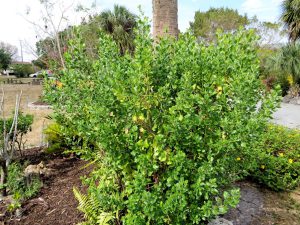It is fairly common for gardeners to send us photographs of unknown plants to identify which is always welcome. One plant we get more than once is often an uninvited guest. It is a native and may even fit nicely into your landscape – the saltbush or

. The white fall flowers produce fluffy seeds that blow in the wind spreading randomly across the landscape and may end up in your yard. I once even found one growing out of a rock! This very successful native plant may already be somewhere in your landscape.
Saltbush is seldom planted on its own accord, but normally drops in for an extended stay. Growing up to eight-foot tall, saltbush develops into a vase-shaped to rounded large shrub or small tree. The simple, dentate leaves are alternatively arranged on the branches. Each leaf is up to three -inches long and is gray green on top and silvery-green underneath. This semi-evergreen shrub has multiple branches which can be pruned into small trees over time. There are separate male and female plants each with different flowers shapes and colors – yellow for male and white for female. Pollinators are attracted to these abundant nectar-filled saltbush flowers. The resulting seeds from the female plant are fluffy with a great capacity to travel in the wind across the landscape. A note to mention: caution – the seeds are poisonous to humans.
Other than finding saltbush shrubs on your own property, this plant is often found naturally near retention ponds and drainage ditches, often in habitats favored by wax myrtles. Saltbush is tolerant of flooding, drought, and brackish water. Being native, saltbush are likely available at native nurseries, but are not commonly found on the market elsewhere. Saltbush are very common in nature – sometimes to the degree of almost being “weedy”. In addition to the attractive foliage, saltbush has an added ornamental feature – they flower at a time of year when most other woody plants have nothing to offer.
Go on a treasure hunt today to see if you have a saltbush already on your property – I have several tucked away in nooks and crannies, and I did not plant them. If not today, a saltbush might find your yard another day – depending on which way the wind blows For more information on shade trees suitable for our area, or to ask a question, please visit https://www.facebook.com/CharlotteCountyExtension . You can also call the Master Gardener Volunteer Helpdesk on Mondays, Wednesdays and Fridays from 1 to 4 pm at 764-4340 for gardening help and insight into their role as an Extension volunteer. Ralph E. Mitchell is the Director/Horticulture Agent for UF/IFAS Extension Charlotte County. He can be reached at 941-764-4344 or ralph.mitchell@charlottecountyfl.gov.
Resources:
Gilman, E. F., Watson, D. G., Klein, R. W., Koeser, A. K., Hilbert, D. R. and McLean, D. C. (2018) Baccharis halimifolia – Saltbush. The University of Florida Extension Service, IFAS.
Florida 4-H Forest Ecology (2021) Saltbush. The University of Florida Extension Service, IFAS.
 1
1
